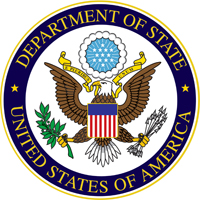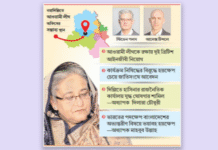Road transport and bridges minister Obaidul Quader, cabinet secretary Khandker Anwarul Islam and officials of the bridges division and the Prime Minister’s Office (PMO) sat in a meeting on 28 March, to decide the opening date and to assess the progress report of the Padma bridge.
The cabinet secretary at an event on 30 March disclosed the meeting outcome and said that the bridge would be opened for vehicular movement on 30 June.
Meanwhile, Prime Minister Sheikh Hasina, while replying to a question at the parliament on 6 April, said work is progressing fast to make the bridge open to traffic by the end of this year.
Later, finance minister AHM Mustafa Kamal, after attending a meeting of the cabinet committee on government purchase on Thursday, told reporters, “I hope we will be able to open it by the end of this year. Our fiscal year will end in June and we believe that we will be able to open it by then.”
When contacted on Friday, bridges division secretary Md Monjur Hossain and Padma bridge project director Md Shafiqul Islam said the issue of Padma bridge launching would be decided by the policy makers of the government. They talked to the high ups and the work is going on as per plan.
The work of Padma bridge has roughly been divided into several parts — main bridge, river training, connecting roads and necessary infrastructure construction, land acquisition, and rehabilitation. All the work, except for the main bridge and river training, have already been completed.
According to the progress report of the Padma Bridge project, some 97 per cent of work on the main bridge was completed until 31 March while the work of river training was completed around 90.50 per cent.
On average, some 92 per cent work of the project was completed until the date.
The tenure of the Padma bridge project is until June 2024, including a one-year defect liability period.
The work of architectural lighting is less likely to be completed on time as some technical complications appeared in the process. It is basically illuminating the bridge on special days, like the Burj Khalifa Tower in Dubai
The contractors have been given time until next June for finishing all work on the main bridge and river training.
But the bridges department said it would take till next December to complete the work of river training. However, there is no technical complication in launching the bridge in the meantime.
20 types of work in progress
Actually, there was no major work left after the installation of the last span on the Padma Bridge on 10 December, 2020.
There were still 20 types of works awaiting completion. Of them, erection of side wall and road divider, and installation of gas pipeline were completed in February.
Later, the installation of lamppost and monorail was also completed. Now, there are 14 types of works left to be done.
The Bridges division divided these 14 works into two – major and minor. There are four major works and 10 minor works left.
According to the project documents, the major works include – placing waterproofing membrane on the structure, pitch-casting on the main bridge and viaduct, and construction of a 400 KV power line.
The work of placing waterproofing membrane was completed 89 per cent until 7 April and is expected to be finished by 18 May.
Besides, the work of casting pitch on the bridge and viaduct is underway. So far, pitch-casting on the main bridge completed 74 per cent and on the viaduct 56 per cent. It is scheduled to be finished by 29 May.
The installation of the 400 KV power line has nothing to do with the opening of the bridge as there is a big gap between the power line and the main bridge. The line would ensure smooth power supply from the southern area to Dhaka.
Some 80 per cent of the power line installation work has so far been completed and it is expected to be completed by 22 June.
Among the minor works, placement of sign-symbols and installation of drainage pipes depend on completion of pitch-casting. Apart from that, the work of installing steel railings at the edges of the bridge, construction of a walkway along the railway line and installation of architectural lighting is yet to be finished.
Many of these works have progressed while some are yet to start. However, all of them are supposed to be completed by 30 June.
Among them, the work of architectural lighting is less likely to be completed on time as some technical complications appeared in the process. It is basically illuminating the bridge on special days, like the Burj Khalifa Tower in Dubai.
However, there is no obstacle to start the vehicular movement on the bridge even if the lightning work is not finished in the meantime.
A source close to the project said that the steel for railing is being imported from the United Kingdom. If the shipment reaches by this month, or the next month, it will take not more than a month to install.
However, the work will not be stuck for this. The deadline for completing the project was earlier extended until June. This time the contractor is not willing to extend the tenure again as it would require extra cost, added the source.
The cost of the Padma Bridge project, which was passed in the ECNEC in 2007, was initially estimated at Tk 10,162 crore. It was increased to Tk 20,507 crore in 2011.
After revising the cost for the second time in 2016, the cost stood at Tk 28,793 crore.
Currently, the cost stands at Tk 30,193 crore after extension of the project tenure for several times. It seems that the project requires another revision before being finished.
According to a survey, the country’s gross domestic product (GDP) would increase at the rate of 1.23 percent once the bridge is opened. The GDP of the south-western region would rise 2.3 per cent.
The bridge would directly connect the Mongla and Benapole ports to Dhaka and Chattogram. Some 19 districts of the south-western region would be connected with the rest of the country thanks to the structure.
Professor Shamim Z Basunia, the chief of the expert committee on the Padma bridge project, told Prothom Alo that work on the main bridge should be completed by June. There are some problems, but let’s see what happens, he said.
* This report appeared in the print and online edition of Prothom Alo and has been rewritten in English by Misbahul Haque










